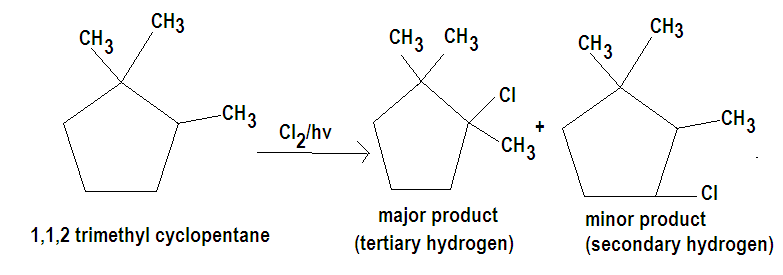
Answer
459.3k+ views
Hint: The above process of heating alkane with $C{l_2}$ is called halogenations and since the halogen is Cl, the process is selectively called chlorination. This will lead to the addition of chlorine atom to the carbon by removing hydrogen atom.
Step by step answer: Chlorination may be brought about by photo irradiation, heat or catalysts. The extent of chlorination depends largely on the amount of chlorine used. A mixture of all possible isomeric monochlorides is obtained, but the isomers are formed in unequal amounts, due to difference in reactivity of primary, secondary and tertiary hydrogen atoms. The order of ease of substitution is:
Tertiary hydrogen> secondary hydrogen > primary hydrogen
The tertiary hydrogen is replaced about 5 times as fast as primary hydrogen where we know that degree of hydrogen depends upon the degree of carbon they are attachéd to. Since in the question we are given with 1,1,2 trimethyl cyclopentane from its structure we can conclude that it has three different types of hydrogen hence the probability of the isomeric products formed are three. Out of which the major product will be formed by chlorination at the tertiary hydrogen.

The major product thus formed is 1-chloro 1,2,2 trimethyl cyclopentane and the other products formed will be due to chlorination at secondary and primary hydrogen.
Hence the correct option is D.
Note: There are three factors that affect the yield of the isomeric products they are:
-Probability factor
-Reactivity of H atom
-Reactivity of X atom in the halogenations reaction, it is maximum for fluorine and does not occur with iodine.
Step by step answer: Chlorination may be brought about by photo irradiation, heat or catalysts. The extent of chlorination depends largely on the amount of chlorine used. A mixture of all possible isomeric monochlorides is obtained, but the isomers are formed in unequal amounts, due to difference in reactivity of primary, secondary and tertiary hydrogen atoms. The order of ease of substitution is:
Tertiary hydrogen> secondary hydrogen > primary hydrogen
The tertiary hydrogen is replaced about 5 times as fast as primary hydrogen where we know that degree of hydrogen depends upon the degree of carbon they are attachéd to. Since in the question we are given with 1,1,2 trimethyl cyclopentane from its structure we can conclude that it has three different types of hydrogen hence the probability of the isomeric products formed are three. Out of which the major product will be formed by chlorination at the tertiary hydrogen.

The major product thus formed is 1-chloro 1,2,2 trimethyl cyclopentane and the other products formed will be due to chlorination at secondary and primary hydrogen.
Hence the correct option is D.
Note: There are three factors that affect the yield of the isomeric products they are:
-Probability factor
-Reactivity of H atom
-Reactivity of X atom in the halogenations reaction, it is maximum for fluorine and does not occur with iodine.
Recently Updated Pages
At what temperature will the total KE of 03 mol of class 11 chemistry JEE_Main

The locus of the center of circle which touches y 12 class 11 maths JEE_Main

If the two circles x 12 + y 32 r2 and x2 + y2 8x + class 11 maths JEE_Main

If one of the diameters of the circle given by the class 11 maths JEE_Main

If from any point P on the circle x2 + y2 + 1gx + 2fy class 11 maths JEE_Main

Let ABCD be a quadrilateral with area 18 with side class 11 scq JEE_Main

Trending doubts
Which is the longest day and shortest night in the class 11 sst CBSE

Why is steel more elastic than rubber class 11 physics CBSE

Difference between Prokaryotic cell and Eukaryotic class 11 biology CBSE

Define the term system surroundings open system closed class 11 chemistry CBSE

In a democracy the final decisionmaking power rests class 11 social science CBSE

In the tincture of iodine which is solute and solv class 11 chemistry CBSE




